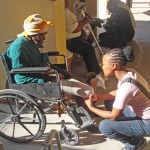Years of war have turned Afghanistan into one of the most mined countries in the world. Landmines have killed and maimed tens of thousands. In this testimony, 28-year-old Mahro recalls the day she came upon unexploded ordnance that robbed her of her sight and the use of one hand.
In 1994, the [...]]]>
Years of war have turned Afghanistan into one of the most mined countries in the world. Landmines have killed and maimed tens of thousands. In this testimony, 28-year-old Mahro recalls the day she came upon unexploded ordnance that robbed her of her sight and the use of one hand.
In 1994, the family was living in Qala-e-Haidar Khan next to Arghandi in Kabul province. They owned cows, and the sale of milk was their main livelihood. As the youngest, it was Mahro’s job to take the cows out to pasture. She remembers how, on one fateful day, she was grazing the family’s cows near a military post with her aunt’s son. “He pulled out something that was half buried in the ground, and hit it with a stone,” she remembers. When the landmine exploded, her cousin, only a bit older than she, died in the blast.
Every side in the successive rounds of fighting in Afghanistan has planted anti-personnel mines. They have been laid in residential areas and on agricultural land. Landmines were planted by the communist regime of President Najibullah, during the fighting with U.S.-supported mujahedin groups. The mujahedin, in turn, mined tracks to villages to prevent the advance of Soviet tanks. Further mine-laying took place between 1996 and 2001 during the conflict between the Taliban government and the Northern Alliance led by Ahmad Shah Massoud. Even today 45 people on average lose their limbs every month to deadly anti-personnel mines, according to Engineer Abdul Wakil, head of the Mine Action Coordination Centre of Afghanistan.
Littered with landmines
Mahro says it was a soldier who had pointed out the grassy knoll by the military post and told the children to take the cows there. “My cousin knew the area well. He had found shards of artillery there. But he did not know the grass could be hiding unexploded landmines,” she says.
Mahro says at the time of the incident a war was raging between mujahedin groups. “There were no Christians or Jews in Afghanistan. The war was among the mujahedin.” Christians and Jews is a reference to the U.S.-led international troops in the country since 2001.
Mahro’s father, who did not want his name revealed, describes it as a time when everyone was armed. He is matter of fact when he recalls the accident that changed his daughter’s future. “They (Mahro and her cousin) were foolish,” he says without a trace of emotion on his face. “They went to a military post, and hit a mine with a stone. The boy was killed and the girl lost her eyes.”
For 40 days, Mahro was in hospital. Her father says she drifted between life and death.
“She had suffered grave injuries, and we rushed her to the Jamhuriat Hospital. But when she was not getting better, we moved her to Sehat-e-Tefel (Indira Gandhi Children’s Hospital in Kabul).”
Utter frustration
At first it seemed one of her eyes could be saved, but doctors operated because they feared her brain would suffer permanent damage. After 40 days the Red Crescent flew Mahro to Germany for further treatment. She learnt how to use her lame hand, but her blindness was beyond treatment.
“I returned to the country after one year. I was in depression, though I was only a child,” Mahro remembers. “I did not have a specific problem, I was free to move around the house, but I was very sad.”
One problem that nagged her was the fact that she could not recall parts of the Holy Quran and some of Hafiz’s poems (a great Persian poet) that she had learnt by heart before the accident. “I would keep telling my family I have forgotten whatever I’ve learnt.”
Slowly she adapted to living without the gift of sight. What she had forgotten, she relearnt with the help of an aunt, uncle and two siblings. She learnt the holy book by heart – the commentary, translation and rules of reciting. “I was always interested in the Holy Quran,” she says, recalling how she stayied with a relative for eight months to study it. He was also Hafiz – one who has learnt the Holy Quran by heart, she says. “I stayed for eight after she got out of the hospital. “When I returned home, I kept learning.,” she says, until, with the help of cassette tapes, she finally mastered the full 30 chapters.
Since 2007 she has been a teacher of the holy book. Now 28, she lives in Kabul’s Gulbagh area where she teaches more than 40 students. “I don’t know how many students I’ve taught,” she says modestly. But to her students, she’s a teacher like any other.
*Kreshma Fakhri writes for Killid, an independent Afghan media group in partnership with IPS. By distributing the testimonies of survivors of war through print and radio, Killid strives for greater public awareness about people’s hopes and claims for justice, reconciliation and peace across Afghanistan.
]]>A screw-on hand and the slogan: “Fake watches are for fake people. Be authentic. Buy real.”
The ad is part of a campaign against counterfeiting launched by the Geneva-based Fondation de la Haute Horlogerie last month.
I might have [...]]]>

A screw-on hand and the slogan: “Fake watches are for fake people. Be authentic. Buy real.”
The ad is part of a campaign against counterfeiting launched by the Geneva-based Fondation de la Haute Horlogerie last month.
I might have ignored it but the day I saw it in a magazine, I had been interviewing amputees and photographing artificial limbs, not unlike the hand in the ad, for a story.
Ndozi Xhaudi is a 79-year-old grandmother from Botswana who got a prosthetic leg through an aid group in June. For the first time in years, Xhaudi left the wheelchair and walked.
Tarina Coetzee, the physiotherapist who helped Xhaudi, recalls that it was her biggest dream to walk again. Now she could make tea and food for herself and be less of a burden on her family.
I spent time in Pretoria with Mohammad Saib, 13, who was born without legs. He goes to school, runs on the treadmill, and plays paintball thanks to his prostheses – you could call them fake limbs.

Ndozi Xhaudi. Courtesy ICExpress Progressive Prosthetics
I stared at the ad. How would Xhaudi and Saib feel about it?
I am sure the Fondation and its ad agency did not mean any disrespect. They probably never thought about a link between fake hands and real people with real needs.
This is part of the problem: the invisibility of people with disabilities.
Even the Millennium Development Goals forgot them, says the International Disability and Development Consortium. Disability is not included in MDG indicators and targets, although it affects all eight MDGs (see their slideshow).
Landmines and diamonds
This is not as surprising as it sounds. Disabled people consistently face discrimination and disadvantage. Eight out of ten live below the poverty line. One in five of the world’s poorest people are disabled, says the Consortium.
The World Bank estimates there are 300 million women with disabilities, and most live in poor countries. Moreover, women are the main carers of the disabled.
Women suffer gender-specific disabilities from obstructed labour, domestic violence and female genital mutilation. Blindness, multiple sclerosis and osteoporosis affect more women then men.
Besides disease, landmines and cluster bombs maim people. So do blood diamonds. In Sierra Leone’s diamond-fueled civil war, rebels hacked people’s arm at the elbow or the shoulder. They offered their victims a choice between “short sleeve or long sleeve”.
Last November, a fake (truly fake) satirical ad about blood diamonds annoyed South African diamond De Beers so much it tried to force the web provider to take down the offending website, which featured a hilarious spoof of the New York Times published on line and in print by a group of artists.
In the fake ad, a white female hand with a glittering diamond ring reaches out to a black prosthetic hand. The punch line: Your diamond purchase will enable De Beers “to donate a prosthetic for an African whose hand was lost in diamond conflicts.” See it here.
I have a friend who covered the civil war in Sierra Leone. Up to this day she can’t look at shops that have mannequins without arms. “My friends think I’m weird,” she says.
I don’t. I think she is sensitive to other realities far away from expensive, status-symbol watches and jewelry stores.
(Read about people with disabilities in Argentina, India and Tanzania.)
]]>